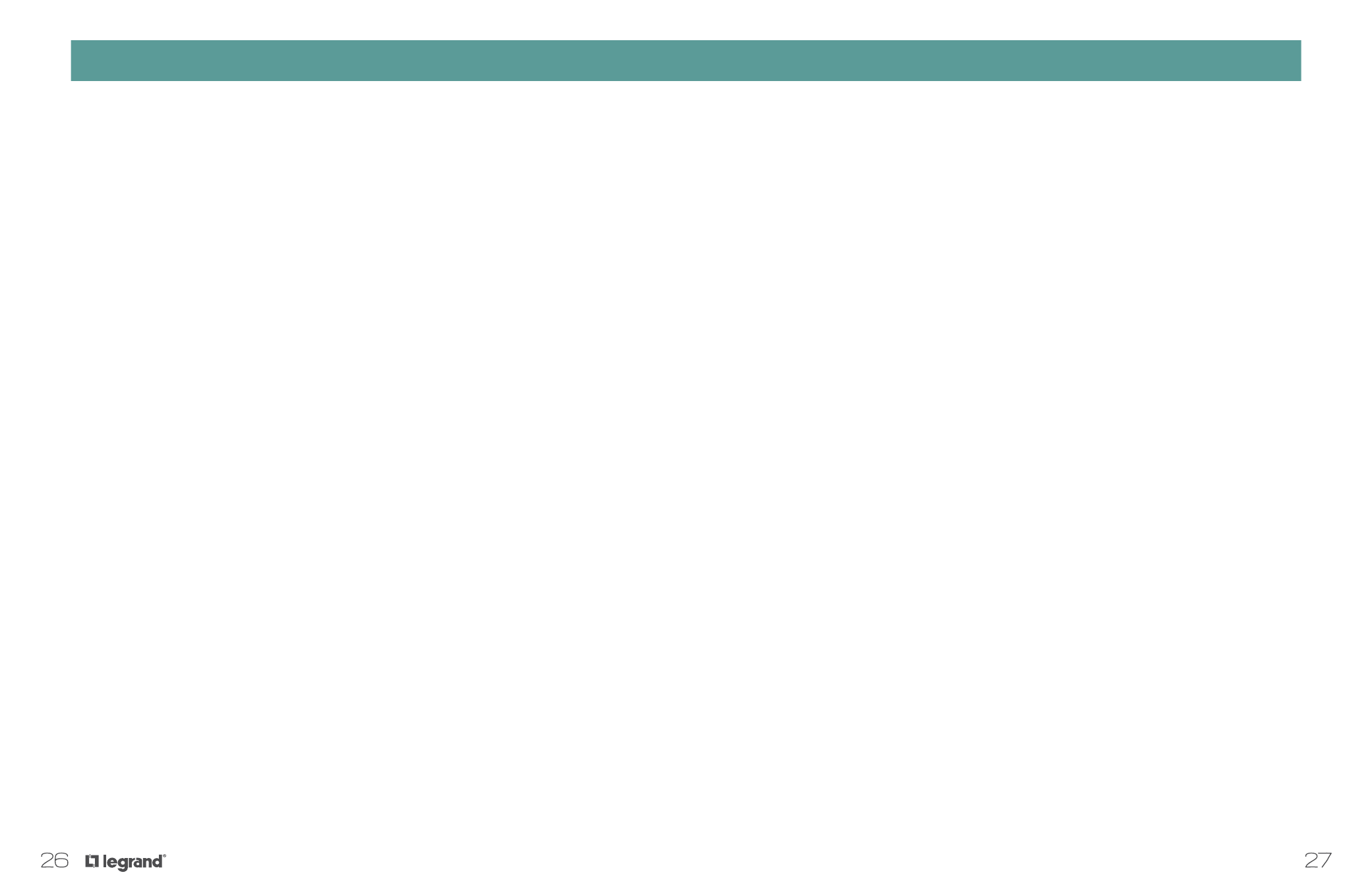Specifications, Switches, dimmers, outlets, and accessories – Legrand ADWHRM4 adorne Wireless User Manual
Page 15

27
26
Dimmers and Switches for Permanent Installation
Dimmers shall incorporate all the dimmer features indicated
above with the exception of wireless remote control.
Switches shall incorporate an air-gap relay providing zero-
crossing switching of any loads up to 1500 watts. The switch
shall be controlled manually by pressing the on/off button.
Plug-in Lamp and Appliance Modules
The Plug-in Lamp and Appliance Modules shall function
exactly as described above for the Tru-Universal Dimmer
and the Switch.
The Plug-in Modules shall plug into any grounded 120 volt
15 amp or 20 amp receptacle, and shall pass the ground
connection through to the load, which shall connect to a
grounded 15 amp receptacle embodied into the Plug-in
Module.
The Plug-in Lamp Module shall function as a Universal
Dimmer, with a maximum load of 300 watts. The Plug-
in Appliance Module shall function as a switch, with a
maximum load of 800 watts.
The Plug-in Lamp Module shall sense the load connected
to it and switch on if it senses that the load circuit is being
opened and closed (i.e., person turning switch on or off). It
shall be possible to configure the Plug-in Appliance Module
to do the same, for use with non-dimmable floor and table
lamps.
The Wireless Network
It shall be possible to construct a distributed peer-to-peer
network of dimmers, controllers, and other devices, using
the unlicensed 900MHz radio band. Each device in the
network shall have an RF range of not less than 100’ in a
timber construction building. It shall be possible to increase
this range to 300’ by the use of two Repeaters.
It shall not be necessary to apply filters or bridges to the
building’s power supply to correctly operate the wireless
network.
All communications across the wireless network shall be
bi-directional, at a speed (baud rate) not less than 9600
baud. The wireless network shall incorporate means to
avoid message contention and shall operate dynamically
over at least five channels in the permitted band to avoid
interference with other 900MHz devices.
The wireless network shall automatically establish a system
(House) ID, and shall provide that ID to each member of the
network. It shall not be possible for neighboring systems to
interfere with or to be influenced by other similar systems.
The use of special tools or computers to configure or
program the wireless network shall not be a requirement.
The wireless network shall support, within system range,
at least 255 discrete House IDs, 127 rooms per house, 1023
devices/groups per house. The recommended maximum
load capacity is 100. Beyond this please contact Legrand
support.
Wireless Groups
It shall be possible to GROUP two or more wireless dimmers,
switches, Plug-in Lamp Modules,
Plug-in Appliance Modules, or wireless remote controls
together without the use of tools or coding devices. When so
grouped, the devices shall act as one.
SWITCHES, DIMMERS, OUTLETS, AND ACCESSORIES
Specifications
Specifications
SPECIFICATIONS
SPECIFICATIONS
Physical
All wireless devices and accessories shall be UL listed and
FCC approved as required.
All wireless devices for installation in standard NEMA
electrical wall boxes shall incorporate heavy duty plated
steel or aluminum straps, with auto-alignment snaps
designed to locate accurately on a plated steel subframe.
Devices shall be available in adorne white or magnesium.
Thermoset materials shall not be acceptable.
Devices shall mount to an adorne wall plate that requires a
maximum of two screws per gang to mount the device and
its wall plate or its portion of a multi-gang wall plate. No
screws shall be visible from the front of the wall plate.
Switches
Single pole, 3-way and 4-way switches with pilot lights shall
incorporate multicolor light emitting diodes. The pilot light
shall be on when the circuit is off in white with the option to
turn this feature off.
Switches shall incorporate pressure plate backwire
terminals.
Dimmers
All Tru-Universal dimmers shall incorporate automatic load
sensing firmware causing the dimmer to close down and
signal an error condition to the user in the event that the
dimmer is energized with an overload or load side short
circuit condition, without causing damage to the dimmer,
and without the use of integral fuses or current trips. The
dimmer FW shall be configurable via the user to provide
Forward Phase or Reverse Phase dimming.
All dimmers shall be controlled using an on/off button and
paddle covering the whole of the front of the device, with no
surrounding rim.
• Tapping the on/off button once shall cause the dimmer to
return to its last used non-zero level.
• Tapping the on/off twice shall cause the dimmer to go to
full bright.
• Tapping and holding the on/off for about 2 seconds will
cause the dimmer to fade the circuit to off over 30 seconds.
• Tapping + once from off will cause the dimmer to return to
its last used non-zero level.
• Tapping + once from ON will increase the lighting level 2%
per tap.
• Tapping + twice from off will go to full bright.
• Tapping+ twice from on will increase the lighting level 2%
(2% for each tap).
• Pressing and holding + will gradually increase the level
until released.
• Tapping – once from on will decrease the level by 2%.
• Tapping – twice from on will decrease the level by 4%
(2% for each tap).
• Pressing and holding – from on will decrease the light
level.
All dimmers shall incorporate a status LED, providing
indication of correct function and various fault conditions.
All permanently-installed dimmers shall incorporate
a means to isolate the load for relamping, without any
switches or other controls visible from the front of the
dimmer, and without requiring tools.
Incandescent Dimmers
Dimmers designated as incandescent dimmers shall be
rated for use with incandescent loads only. Incandescent
dimmers shall be designed to be inserted in series with a
resistive load and shall not require a neutral connection.
